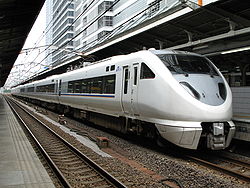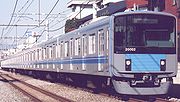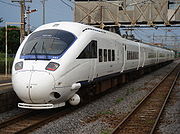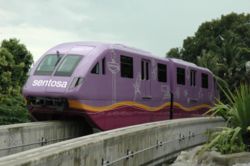
Hitachi A-train
Encyclopedia



Japan
Japan is an island nation in East Asia. Located in the Pacific Ocean, it lies to the east of the Sea of Japan, China, North Korea, South Korea and Russia, stretching from the Sea of Okhotsk in the north to the East China Sea and Taiwan in the south...
. The A-train family comprises trains for both commuter services and limited express
Limited express
A limited express is a type of express train service. It refers to an express service that stops at a limited number of stops in comparison to other express services on the same or similar routes.- Japan :...
services. Hitachi has given the family a modular design which enables both production and refurbishment to be undertaken faster. The A-train's strong and attractive-looking body is the result of the use of revolutionary technology called friction stir welding (FSW)
Friction stir welding
Friction-stir welding is a solid-state joining process and is used for applications where the original metal characteristics must remain unchanged as far as possible...
. Due to the low heat input of this patented process high strength, excellent crashworthiness and minimal distortion can be achieved.
Japanese rail units
Hitachi has provided a number of trains based on the A-train concept for use in Japan:- E257 seriesE257 seriesThe is a DC electric multiple unit operated by East Japan Railway Company and built jointly by Hitachi, Kinki Sharyo, and Tokyu Car Corporation...
- a limited express EMU operated by the East Japan Railway CompanyEast Japan Railway Companyis the largest passenger railway company in the world and one of the seven Japan Railways Group companies. The company name is officially abbreviated as JR East in English, and as in Japanese. The company's headquarters are in Yoyogi, Shibuya, Tokyo....
(JR East). - 815 series815 seriesThe 815 series is an AC electric multiple unit type operated on local services by Kyushu Railway Company in Japan since 1999.-Design:...
- a commuter EMU operated by the Kyushu Railway CompanyKyushu Railway CompanyThe , also referred to as , is one of the constituent companies of Japan Railways Group . It operates intercity rail services in Kyushu, Japan and the JR Kyushu Jet Ferry Beetle hydrofoil service across the Tsushima Strait between Fukuoka and Busan, South Korea.When Japan Railways was divided in...
(JR Kyushu) and the first A-train type to enter service. - 817 series817 seriesThe 817 series is an AC electric multiple unit type operated on local services by Kyushu Railway Company in Japan since 2001. The design was based on the earlier 815 series, with transverse seating replacing the previous longitudinal seating....
- a commuter EMU operated by the Kyushu Railway CompanyKyushu Railway CompanyThe , also referred to as , is one of the constituent companies of Japan Railways Group . It operates intercity rail services in Kyushu, Japan and the JR Kyushu Jet Ferry Beetle hydrofoil service across the Tsushima Strait between Fukuoka and Busan, South Korea.When Japan Railways was divided in...
(JR Kyushu). - 683 series683 seriesThe is a dual-voltage electric multiple unit type operated by West Japan Railway Company and Hokuetsu Express on limited express services in Japan.-Variants:* 683-0 series * 683-1000 series...
- a limited express EMU operated on the Hokuriku Main LineHokuriku Main LineThe is a 358.3 kilometer line of the West Japan Railway Company from Maibara Station in Maibara, Shiga to Naoetsu Station in Jōetsu, Niigata. It serves the Hokuriku region on the northern central coast of Honshū, the largest island of Japan, as well as offering connections to the regions of...
by the West Japan Railway CompanyWest Japan Railway Company, also referred to as , is one of the Japan Railways Group companies and operates in western Honshū. It has its headquarters in Kita-ku, Osaka.-History:...
(JR West). - 883-1000 series883 seriesThe is an AC electric multiple unit tilting train type operated on Sonic limited express services by Kyushu Railway Company in Japan since April 1995.-Formations:...
- additional cars built to augment existing 883 series Sonic EMUs operated by the Kyushu Railway Company (JR Kyushu). - 885 series885 seriesThe is an AC electric multiple unit type operated on limited express services by Kyushu Railway Company in Japan. The type is part of Hitachi's A-train family of multiple units.-Operations:...
- a limited express EMU operated by the Kyushu Railway Company (JR Kyushu). - Fukuoka Subway 3000 seriesFukuoka Subway 3000 seriesThe is an electric multiple unit operated by Fukuoka City Transportation Bureau on the Nanakuma Line in Fukuoka, Japan.-History:The 3000 series was introduced on 3 February 2005 on the newly opened Nanakuma Line between and...
- an EMU type operated on Fukuoka City SubwayFukuoka City SubwayThe serves Fukuoka, Japan. It consists of three subway lines, the Kūkō, or Airport Line, the Hakozaki Line and the Nanakuma Line).The lines are operated by the . Unlike most other public operators in Japan, the company only operates subways without any bus lines....
's Nanakuma Line. - Hankyū 9000 series - a commuter EMU operated by Hankyu RailwayHankyu Railwayis a Japanese private railway that provides commuter and interurban service to the northern Kansai region and is one of major businesses operated by Hankyu Hanshin Holdings, Inc. The railway's main terminal is at Umeda Station in Osaka...
. - Hankyū 9300 series - a commuter EMU operated by Hankyu RailwayHankyu Railwayis a Japanese private railway that provides commuter and interurban service to the northern Kansai region and is one of major businesses operated by Hankyu Hanshin Holdings, Inc. The railway's main terminal is at Umeda Station in Osaka...
. - Seibu 20000 series - a commuter EMU operated by the Seibu RailwaySeibu Railwayis a conglomerate based in Tokorozawa, Japan, with principal business areas in railways, tourism and real estate. Seibu Railway's operations are concentrated in northwest Tokyo and Saitama Prefecture; the name "Seibu" is an abbreviation of "west Musashi," referring to the historic name for this area...
. - Seibu 30000 seriesSeibu 30000 seriesThe is a commuter EMU train type operated by Seibu Railway in Japan. It is nicknamed the "Smile Train".A total of 120 4-door vehicles are on order to be delivered between fiscal 2007 and 2011, replacing older 3-door 101 series and 301 series sets...
- a commuter EMU operated by the Seibu RailwaySeibu Railwayis a conglomerate based in Tokorozawa, Japan, with principal business areas in railways, tourism and real estate. Seibu Railway's operations are concentrated in northwest Tokyo and Saitama Prefecture; the name "Seibu" is an abbreviation of "west Musashi," referring to the historic name for this area...
. - Tōbu 50000 seriesTobu 50000 seriesThe is a commuter electric multiple unit operated by Tōbu Railway in Japan, manufactured by Hitachi to its "A-train" concept. The trains represent the first use of aluminium body cars on Tōbu commuter trains...
- a commuter EMU operated by the Tōbu RailwayTobu Railwayis a Japanese commuter railway company in the Greater Tokyo Area as well as an intercity and regional operator in the Kantō region. It operates in Tokyo, Saitama, Chiba, Tochigi, and Gunma Prefectures...
. - Tōkyō Metro 05 seriesTokyo Metro 05 seriesThe is an electric multiple unit which operates on the Tokyo Metro Tōzai Line in Japan.They were built from 1988 to 2004 so they have a number of variants. Sets 05-125 onward have a redesigned front end, and are called "05N series". Sets 05-114 to 05-118 have wide doors...
- an EMU type operated on the Tokyo MetroTokyo Metrois one of two rapid transit systems making up the Tokyo subway system, the other being Toei. It is the most used subway system in the world in terms of annual passenger rides.-Organization:...
's Tōzai LineTokyo Metro Tozai LineThe is a rapid transit line owned and operated by Tokyo Metro located in Tokyo and Chiba Prefecture, Japan. Its name literally means East-West Line. The line runs between Nakano Station in Nakano, Tokyo and Nishi-Funabashi Station in Funabashi, Chiba...
. - Tōkyō Metro 10000 seriesTokyo Metro 10000 seriesThe is an electric multiple unit type which operates on the Yūrakuchō and Fukutoshin subway lines of Tokyo Metro in Japan.-Design:The trains are manufactured by Hitachi with aluminium bodies to its "A-train" concept....
- an EMU type operated on the Tokyo MetroTokyo Metrois one of two rapid transit systems making up the Tokyo subway system, the other being Toei. It is the most used subway system in the world in terms of annual passenger rides.-Organization:...
's YūrakuchōTokyo Metro Yurakucho LineThe is a subway line owned and operated by Tokyo Metro. The line connects Wakōshi Station in Wakō, Saitama and Shin-Kiba Station in Kōtō, Tokyo. On maps, diagrams and signboards, the line is shown using the color "gold" , and its stations are given numbers using the letter Y.The proper name as...
and Fukutoshin lines. - Tōkyō Metro 15000 seriesTōkyō Metro 15000 seriesThe is an electric multiple unit type operated by Tokyo Metro on the Tokyo Metro Tōzai Line in Tokyo, Japan, since May 2010. Thirteen 10-car sets are scheduled to be delivered by fiscal 2011.-Design:...
- an EMU type operated on the Tokyo MetroTokyo Metrois one of two rapid transit systems making up the Tokyo subway system, the other being Toei. It is the most used subway system in the world in terms of annual passenger rides.-Organization:...
's Tōzai LineTokyo Metro Tozai LineThe is a rapid transit line owned and operated by Tokyo Metro located in Tokyo and Chiba Prefecture, Japan. Its name literally means East-West Line. The line runs between Nakano Station in Nakano, Tokyo and Nishi-Funabashi Station in Funabashi, Chiba...
. - Tōyō Rapid 2000 seriesToyo Rapid 2000 seriesThe is an electric multiple unit operating on the Tōyō Rapid Railway, an extension of Tokyo Metro Tōzai Line. It replaces the Tōyō Rapid 1000 series....
- a commuter EMU operated by the Tōyō Rapid Railway LineToyo Rapid Railway LineThe is a commuter rail line owned by Tōyō Rapid Railway Co., Ltd., that runs between Nishi-Funabashi Station in Funabashi City, Chiba and Tōyō-Katsutadai Station in Yachiyo City, Chiba. The name means 東京 and 千葉 ....
. - TX-1000 seriesTX-1000 seriesThe is an electric multiple unit type operated by the Metropolitan Intercity Railway Company on the Tsukuba Express line in the Kantō region of Japan since 2005. A total of 84 cars were delivered.-Design:...
- a commuter EMU operated by the Metropolitan Intercity Railway CompanyMetropolitan Intercity Railway CompanyThe is a third sector railway company. It was established in March, 1991, to construct the Tsukuba Express . Municipalities along the planned line, and private corporations, invested in it.-External links:...
on Tsukuba Express services, built by Kawasaki Heavy IndustriesKawasaki Heavy Industriesis an international corporation based in Japan. It has headquarters in both Chūō-ku, Kobe and Minato, Tokyo.The company is named after its founder Shōzō Kawasaki and has no connection with the city of Kawasaki, Kanagawa....
to A-train specifications. - TX-2000 seriesTX-2000 seriesThe is a dual-voltage electric multiple unit type operated by the Metropolitan Intercity Railway Company on the Tsukuba Express line in the Kantō region of Japan since 2005. As of January 2011, a total of 120 cars were in operation...
- a commuter EMU operated by the Metropolitan Intercity Railway CompanyMetropolitan Intercity Railway CompanyThe is a third sector railway company. It was established in March, 1991, to construct the Tsukuba Express . Municipalities along the planned line, and private corporations, invested in it.-External links:...
on Tsukuba Express services.
A-train overseas


Sentosa Express
Sentosa Express is a monorail line connecting Sentosa island to HarbourFront on the Singapore mainland across the waters.Built at a cost of S$140 million, development started in June 2003 and was completed in December 2006. The fully elevated 2.1-kilometre two-way line and three out of four...
in Singapore utilise A-train derived cars. However, Hitachi's first major conventional rail order outside Japan came when Southeastern
Southeastern (train operating company)
London & South Eastern Railway Limited, trading as Southeastern is a train operating company in south-east England. On 1 April 2006 it became the franchisee for the new Integrated Kent Franchise , replacing the publicly owned South Eastern Trains on the former South East Franchise...
ordered a total of 29 EMUs for use running the domestic services on High Speed 1 in the United Kingdom. The Class 395
British Rail Class 395
British Rail Class 395 is a dual-voltage electric multiple unit used by train operating company Southeastern for its services along High Speed 1 and onwards to the Kent coast. The trains were built in Japan by Hitachi and shipped to the United Kingdom to operate new high speed domestic services...
units are standard gauge
Standard gauge
The standard gauge is a widely-used track gauge . Approximately 60% of the world's existing railway lines are built to this gauge...
and designed to operate at speeds of up to 225 km/h (140 mph).
At approximately the same time as the UK order, Hitachi received an order from Taiwan Railway Administration
Taiwan Railway Administration
The Taiwan Railway Administration is an agency of the Ministry of Transportation and Communications of the Republic of China responsible for managing, maintaining, and running passenger and freight service on 1097 km of conventional railroad lines in Taiwan...
(TRA) for six 8-car trains, based on the Japanese 885 series
885 series
The is an AC electric multiple unit type operated on limited express services by Kyushu Railway Company in Japan. The type is part of Hitachi's A-train family of multiple units.-Operations:...
, designated as TEMU1000, for operation on the main line between Taipei
Taipei
Taipei City is the capital of the Republic of China and the central city of the largest metropolitan area of Taiwan. Situated at the northern tip of the island, Taipei is located on the Tamsui River, and is about 25 km southwest of Keelung, its port on the Pacific Ocean...
and Hualien. Deliveries of the trains began in late 2006, with the first public test of the new trains in March 2007.
In 2007, Korail
Korail
Korea Railroad Corporation , promoted as Korail , is the national railroad operator in South Korea.Korail operates passenger and freight trains throughout South Korea...
ordered eight 4-car express trains branded as the Trunk-Line Electric Car (TEC) to Hitachi. These car body, bogies, power systems made in Japan, but were to be assembled at SLS Heavy Industry in Changwon
Changwon
Changwon is a city in and the capital of Gyeongsangnam-do in South Korea. Changwon city is 8th most populous city in South Korea, with a 2010 established population of 1,089,039. It encompasses a land area of on southeastern of South Korea. The population of Southeastern part of Korea, that...
, Korea.
The trains were for deployment on "Rapid Train" services on the Gyeongbu Line
Gyeongbu Line
The Gyeongbu Line is the most important railway line in South Korea and one of the oldest. It was constructed by Japan in 1905, connecting Seoul to Suwon, Daejeon, Daegu, and Busan. The Gyeongbu Line is by far the most heavily travelled rail line in South Korea...
and Janghang Line
Janghang Line
The Janghang Line is a railway line serving South Chungcheong Province in South Korea. The line connects Cheonan to the railway junction city of Iksan. The Janghang Line is served by frequent Saemaul-ho and Mugunghwa passenger train services between Seoul and Iksan...
between Seoul station
Seoul Station
Seoul Station is a major railway station in Seoul, South Korea. The station is served by the Gyeongbu Line, its high-speed counterpart and the Gyeongui Line, with frequent high-speed, express, and local services to various points in South Korea.-Services:...
and Sinchang Station
Sinchang Station
Sinchang Station is a railway station on Seoul Metropolitan Subway Line 1 and the Janghang Line in Asan, South Korea. It is the southern terminus for metro trains on Line 1. Its secondary name is Soonchunhyang University Station, named for nearby Soonchunhyang University.- References :...
, branded Nooriro and with a maximum speed of 150 km/h.
Hitachi gained further ground in the UK market when it was announced that an A-train based design similar to that of the Class 395, initially named the "Hitachi Super Express", won the United Kingdom Government's Intercity Express Programme
Intercity Express Programme
The Intercity Express Programme is an initiative of the Department for Transport in the United Kingdom to procure new trains to replace the InterCity 125 fleet on the East Coast Main Line and Great Western Main Line, as well as replacing other trainsets on long distance services from London to...
tender. The order covers up to 1,400 new multiple unit vehicles, commissioned as five- and ten-car sets. The vehicles will used electric traction powered from electric, diesel, or "bi-mode" power sources. "Bi-mode" sets will be formed of one electric and one diesel power car per set.
The choice of Hitachi units which would see little final manufacturing in the UK over the foreign owned but domestically manufactured Bombadier option was controversial, particularly in the area that would have manufactured them leading to campaign to reverse the decision. It was however economics which became a sticking point with the weight of the design creeping up (though some accused the Dft of producing impossible specification requirements) and reportedly difficult negotiations over final unit price and the production balance between the different power options. The inability or reluctance of the financial markets to provide the necessary capital was the final straw leading to the announcement in Feb 2010 of a three month independent review into the value for money of the programme and looking at alternate options such as life extension of existing IC125 stock.

